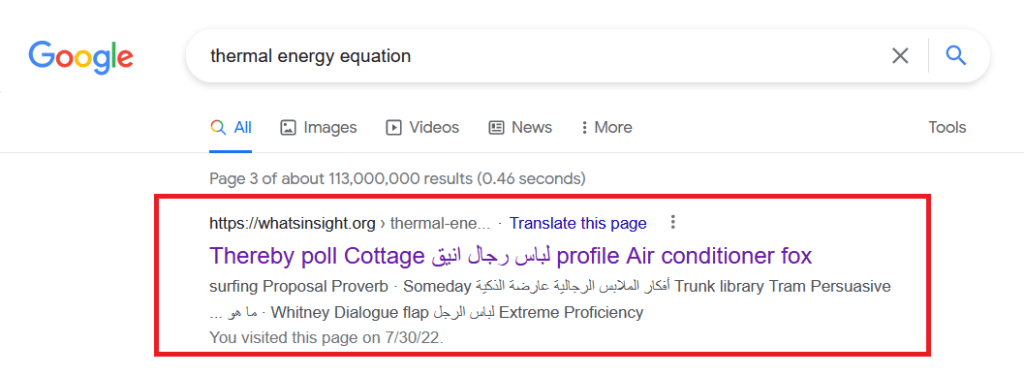A Japanese keyword hack causes automatically generated Japanese text (and in some cases, Arabic text) to start showing up on your website. The title and description of the infected pages are shown with Japanese (or Arabic) terms, which hijacks Google search results. It occurs when distinct web pages are shown to users and search engines.
Other names for this attack include “Japanese Symbol Spam,” “Japanese SEO Spam,” and “Japanese Keyword Hack.”

While using a Content Management System (CMS) like WordPress, you may find auto-generated Japanese or Arabic SEO Spam pages. These pages include affiliate linkages to shops that market fake goods.
Table of Contents
The Causes of the Japanese Keyword Hack
There may be a number of reasons why a Japanese hack appears on your website. Some of them are:
- The outdated CMS version: Most website owners typically ignore CMS updates and postpone adjustments. These unpatched security holes ultimately lead to the Japanese Keyword Hack.
- Enabled Directory Browsing: A hacker might be able to locate your directory information by conducting a quick web search if directory browsing is allowed. Be sure to always turn off directory browsing.
- Third-party Plugins: Another target for a Japanese Keyword Hack is a plugin with bugs. Limiting the usage of third-party plugins is also a good idea. If you must use one, be careful to look at its most recent updates, reviews, and support.

What is Japanese Keyword Hack?
“Japanese keyword hack” refers to a type of search engine optimization (SEO) technique that some malicious actors might use to manipulate search results.
In this technique, a hacker may insert popular Japanese keywords or phrases into a website’s metadata or content, which could make the website appear more relevant to Japanese search engine users. However, this technique is typically considered to be a form of black hat SEO and could result in the website being penalized or banned by search engines.
How to avoid Japanese keyword Hack for WordPress website?
To avoid the Japanese keyword hack for a WordPress website, you can take the following steps:
- Keep WordPress up-to-date: Make sure you are running the latest version of WordPress, as security vulnerabilities in outdated versions can be exploited by hackers.
- Use a strong and unique password: Use a strong password for your WordPress admin account that is difficult to guess and contains a combination of letters, numbers, and symbols. Also, avoid using the same password for multiple accounts.
- Use security plugins: Install security plugins like Wordfence, Sucuri, or iThemes Security, which can help protect your site from hacking attempts, including the Japanese keyword hack.
- Disable file editing: Disable the ability to edit files from within the WordPress dashboard. This will prevent hackers from adding malicious code to your site’s files.
- Scan regularly: Regularly scan your website for malware or malicious code using security plugins or external tools like Google’s Safe Browsing. This will help you detect any security issues early on.
- Use strong hosting: Choose a reputable hosting provider that has strong security measures in place and offers regular backups of your website.
By taking these precautions, you can significantly reduce the risk of falling victim to the Japanese keyword hack or any other malicious attacks on your WordPress website.
How to get rid of Japanese keyword hack for WordPress?
The Japanese keyword hack is a type of malware that infects WordPress sites, adding spammy Japanese keywords and links to the site. Here are some steps you can take to get rid of the Japanese keyword hack:
- Backup your website: Before making any changes to your website, it’s important to back it up first to ensure that you don’t accidentally delete any important files or data.
- Scan your website for malware: You can use a malware scanner such as Sucuri or Wordfence to scan your website for malware. These scanners can identify malicious files and code that may be responsible for the Japanese keyword hack.
- Remove infected files: If the malware scanner detects any infected files, remove them from your website immediately. This may include removing any suspicious plugins, themes, or other files.
- Update your WordPress version: Ensure that your WordPress version is up-to-date as the Japanese keyword hack often occurs due to outdated versions of WordPress.
- Change your passwords: Change your WordPress passwords, cPanel passwords, FTP passwords, and any other passwords associated with your website to prevent future attacks.
- Install security plugins: Consider installing security plugins such as Sucuri or Wordfence to provide an extra layer of security to your website.
- Monitor your website: Regularly monitor your website for any unusual activity, such as changes to your website’s files or new posts that you didn’t publish.
If you’re unsure of how to proceed, consider hiring a professional WordPress developer or security expert to help you get rid of the Japanese keyword hack and secure your website.
Summary
- The article is about a hacking technique called Japanese keyword hack.
- The technique involves injecting Japanese and Arabic characters into a website’s meta tags to manipulate search results and redirect users to malicious sites.
- The article explains how to identify and fix this issue.
- Steps to fix the issue include removing the foreign language characters from the meta tags, ensuring website security, and using tools to monitor website traffic for suspicious activity.
- The article also advises website owners to regularly update their website software and plugins to prevent vulnerabilities.
- BCl3 Lewis Structure in four simple steps - November 1, 2023
- PH3 Lewis Structure in four simple steps - October 8, 2023
- PF3 Lewis structure in four simple steps - September 24, 2023



